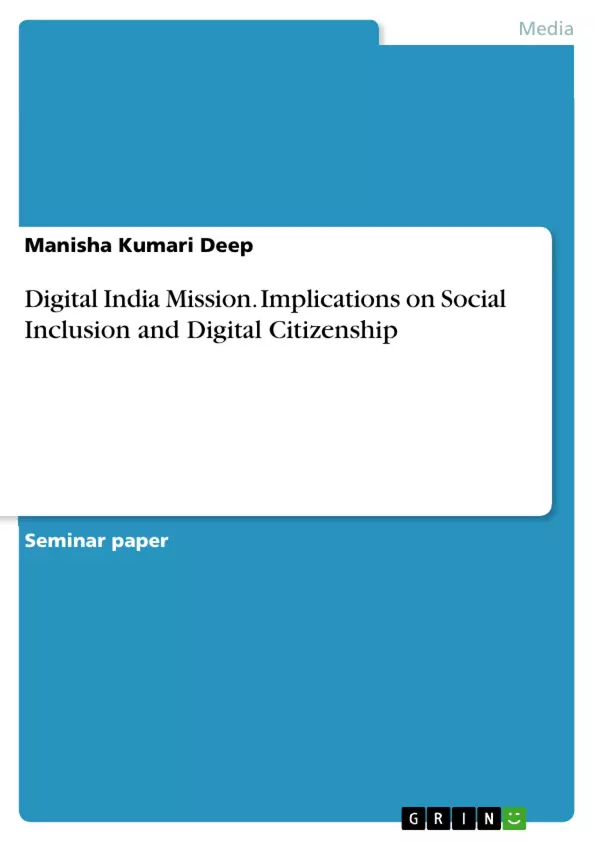Digital India Mission campaign was started by Prime Minister Of India in 2015 with a vision to make rural India part of development and growth. The basic motto of this campaign was to empower people and increase the global presence of the nation. The main objective of this campaign was to connect rural areas of the country with high speed internet. Details on Digital India Mission has been given here. What are the implications of this mission on Social Inclusion has been discussed. Also the much talked about term Digital Citizenship, some of its popular definitions, attributes, and elements have been stated. Implication of Digital India Mission on Digital Citizenship has been discussed. An analysis has been made on achievements and concerns of Digital India Mission towards Digital Citizenship.
Inhaltsverzeichnis (Table of Contents)
- Abstract
- Digital India Mission
- Social Inclusion
- Digital Citizenship
- Conclusion
- References
Zielsetzung und Themenschwerpunkte (Objectives and Key Themes)
This text aims to analyze the impact of the Digital India Mission on social inclusion and digital citizenship in India. It examines the initiative's objectives, achievements, and challenges in bridging the digital divide and promoting equitable access to technology and information.
- The Digital India Mission and its goals.
- The relationship between the Digital India Mission and social inclusion.
- The concept of digital citizenship in the Indian context.
- Assessment of the Digital India Mission's successes and shortcomings.
- Analysis of the challenges and opportunities presented by digital inclusion.
Zusammenfassung der Kapitel (Chapter Summaries)
Abstract: This abstract introduces the Digital India Mission and its relevance to social inclusion and digital citizenship in India. It highlights the vast rural population and the need for bridging the gap between resource availability and utilization, emphasizing the mission's role in promoting sustainable development through financial inclusion and increased access to resources like internet and transportation.
Digital India Mission: This chapter details the Digital India Mission, a government initiative launched in 2015 to provide electronic access to government services and increase internet connectivity. It outlines the mission's three core components: digital infrastructure development, digital service delivery, and universal digital literacy. The chapter further elaborates on the nine pillars of the Digital India Mission, including broadband expansion, universal mobile connectivity, and e-governance initiatives, and also lists 23 additional schemes launched under this umbrella program. These schemes range from Wi-Fi hotspot installations and e-payment portals to IT training programs and cybersecurity initiatives, showcasing the wide-ranging scope of the government's digital inclusion efforts.
Social Inclusion: This section defines social inclusion as the process of improving participation in society, especially for disadvantaged groups, by enhancing opportunities, access to resources, and respect for rights. It emphasizes the importance of overcoming social exclusion based on factors such as region, religion, gender, disability, economic status, appearance, and language, connecting this to the overall goals of the Digital India Mission in bridging societal disparities.
Schlüsselwörter (Keywords)
Digital India Mission, Social Inclusion, Digital Citizenship, Digital Literacy, Internet Connectivity, E-Governance, Rural Development, Bridging the Digital Divide, Sustainable Development, Financial Inclusion.
Frequently Asked Questions: Analyzing the Impact of the Digital India Mission
What is the main focus of this text?
This text analyzes the impact of the Digital India Mission on social inclusion and digital citizenship in India. It examines the initiative's objectives, achievements, and challenges in bridging the digital divide and promoting equitable access to technology and information.
What are the key themes explored in this document?
The key themes include the Digital India Mission's goals, its relationship with social inclusion, the concept of digital citizenship in India, an assessment of the mission's successes and failures, and an analysis of the challenges and opportunities presented by digital inclusion.
What is the Digital India Mission?
The Digital India Mission is a government initiative launched in 2015 to provide electronic access to government services and increase internet connectivity. It has three core components: digital infrastructure development, digital service delivery, and universal digital literacy. The mission includes numerous schemes addressing broadband expansion, universal mobile connectivity, e-governance, Wi-Fi hotspots, e-payment portals, IT training, and cybersecurity.
How does the Digital India Mission relate to social inclusion?
The Digital India Mission aims to bridge the digital divide and promote social inclusion by improving access to technology and information for disadvantaged groups. Overcoming social exclusion based on factors like region, religion, gender, disability, economic status, appearance, and language is central to the mission's goals.
What is digital citizenship in the Indian context?
The text explores the concept of digital citizenship within the context of India's Digital India Mission, highlighting how increased access to technology and information impacts participation and rights within society.
What are the chapter summaries included in this preview?
The preview includes summaries of an abstract introducing the Digital India Mission and its relevance to social inclusion and digital citizenship; a chapter detailing the mission itself, its components, and various schemes; a section defining social inclusion and its connection to the mission; and a keywords section.
What are the key words associated with this analysis?
Key words include: Digital India Mission, Social Inclusion, Digital Citizenship, Digital Literacy, Internet Connectivity, E-Governance, Rural Development, Bridging the Digital Divide, Sustainable Development, and Financial Inclusion.
What is the overall objective of this text?
The overall objective is to provide a comprehensive analysis of the Digital India Mission's impact on social inclusion and digital citizenship in India, assessing its successes, challenges, and overall contribution to sustainable development.
- Citar trabajo
- Manisha Kumari Deep (Autor), 2018, Digital India Mission. Implications on Social Inclusion and Digital Citizenship, Múnich, GRIN Verlag, https://www.grin.com/document/414133



